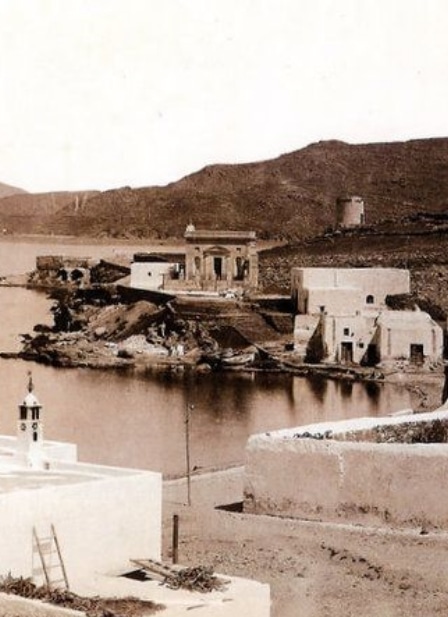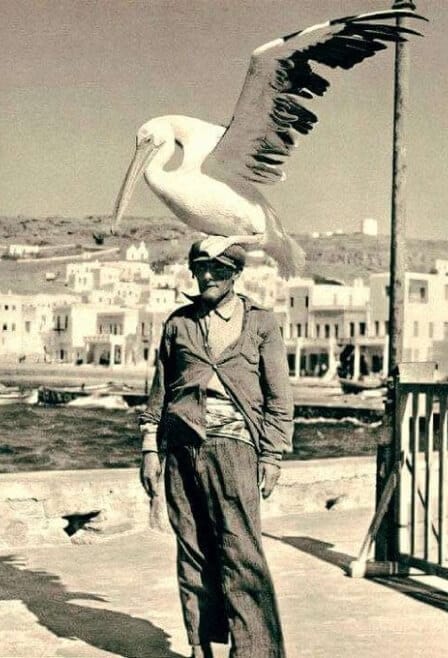Mykonos History
Discover the rich history and mythology of Mykonos island.
Greek Mythology
According to classical mythology, the Giants slain by Hercules in a fierce battle are buried on Mykonos beneath the imposing blocks of Mykonian granite. The name “Mykonos” somewhat pejoratively means a ‘mass of stones’ or a ‘rocky place.’ A later tradition attributes the island’s name to a hero called Mykonos, son of the King of Delos, Anios, who was the son of Apollo and the nymph Rhoio—a descendant of Dionysus.
The Kares and Phoenicians may have been the first inhabitants of Mykonos, but by around 1000 B.C., Ionians from Athens had established colonies and taken control of the island, expelling its earlier inhabitants. Historical sources confirm that, in ancient times, there were two towns on the island. In 490 B.C., the Persian generals Datis and Artaphernes made a brief stopover in Mykonos. The island, known for its poor agricultural resources, was home to pantheistic worship, where Dionysus, Demeter, Zeus, Apollo, Poseidon, and Heracles were the principal gods. Later, the island came under Roman rule and then passed to the Byzantines, who fortified it against Arab raids during the 7th century and maintained control until the 12th century.

Ottoman Empire
Following the fall of Constantinople at the end of the 4th Crusade (1204), Mykonos was taken by Andrea and Jeremia Ghisi—relatives of Dandolo, the Doge of Venice—as their stronghold. In 1292, the island was looted by the Catalans, and in 1390, the last Ghisi overlord handed it over to the Venetians. In 1537, while still under Venetian rule, Mykonos suffered a devastating attack by Barbarossa, the admiral of Suleiman the Magnificent. Later, under Kapudan Pasha, head of the Ottoman fleet, the island was largely self-governed according to the system of the period, by a functionary called a “voivode” and a council (a body of “syndics”), who sought to maintain neutrality between the Turks and Venetians. The Venetians withdrew from the region permanently in 1718 after the fall of the castle of Tinos to the Ottomans.
Throughout this period, the Mykonians were known as excellent sailors, successful in trade and shipping. Piracy was not unheard of either. Many islanders participated in the “Orlof Insurrection” (1770-74), led by the Orloff brothers. The insurrection ended favorably for both them and Catherine the Great, thanks to highly profitable treaties between the Ottoman Empire and the Russian Empire concerning trade.

Greek Revolution of 1821
Soon after the outbreak of the Greek Revolution in 1821, the Mykonians, led by Lady Mando Mavrogenous—a well-educated aristocrat inspired by the fervent ideas of the Enlightenment—successfully prevented the landing of an Ottoman fleet squadron in 1822. The Mykonians actively participated in the war, contributing four armed ships, two of which were fully outfitted and supplied at Lady Mando’s own expense. By the end of the war, she had spent almost her entire family fortune in the cause.
20th Century
Following the establishment of the modern Greek state, the local upper and middle classes revived the island’s economy through consolidated trade relations with southern Russia, Moldavia, and Wallachia. Mykonian merchants established themselves in key cities such as Constantinople, Smyrna, Alexandria, Syros, Livorno, and Marseilles. However, the dominance of steam technology over traditional sailing ships by the end of the 19th century, along with the opening of the Corinth Canal (1904) and the upheavals of World War I, led to a downturn in the local economy. Many Mykonians emigrated to find work abroad, mainly in the United States, or in the growing urban centers of mainland Greece like Piraeus and Athens. The development of tourism in the subsequent decades provided the island with a new means of economic growth.
Successful Growth
The prolonged excavations by the French School of Archaeology, which began in Delos in 1873, drew attention to the region—at least among the select few who, captivated by the charm of classical Greece, had the means and opportunity to travel. By the early 1930s, many famous artists, politicians, and wealthy individuals, primarily from Europe, began vacationing on the island, drawn by its unique atmosphere. Mykonos adapted well to the post-war era and the gradual rise of the tourism industry in Southern Europe. The island has since transformed into a cosmopolitan destination and stands as one of the most successful growth models of its type and scale in Europe.
Mykonos' Sights
